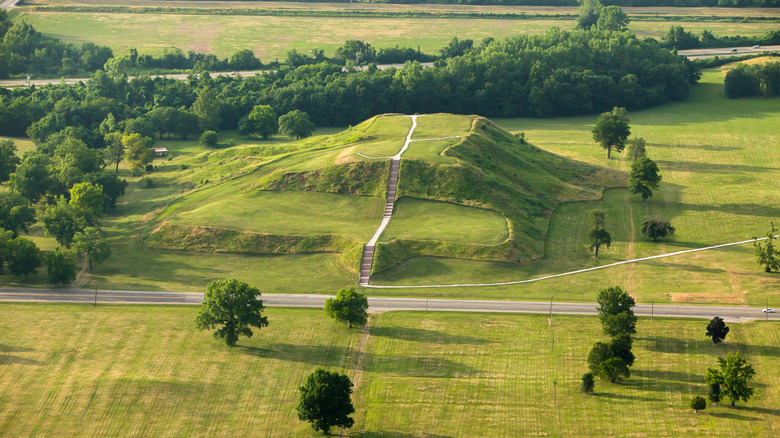Why North America's Ancient Mound Cities Disappeared
Despite their lack of iron tools or suitable draft animals like those present in Europe, Africa, and Asia, the empires of Central and South America were able to perform stunning architectural feats. The Mayans produced massive stone pyramids comparable to those of India and Southeast Asia. The Aztecs continued this practice when they built their capital of Tenochtitlan, which was supported by massive causeways and aqueducts. The Inca of South America, meanwhile, built sprawling roadways to connect their massive empire, constructed using massive yet precisely cut stone (via World History Encyclopedia).
Across the southeast of North America, was the Mississippian culture, that built large cities across the continent for centuries. Focal points of these communities were large mounds of earth, atop of which would be the residence of the community's political or religious leader (via NPS). Cahokia, a city of up to 20,000 in what is now Illinois, was the largest of these, as well as a center of trade and — occasionally — human sacrifice (via All That's Interesting). While the materials used were not as long-lasting as the aforementioned stone structures to the south, the mound cities are believed to have nevertheless been comparable in grandeur. Yet by the 1100s, many of these cities began to disappear with few concrete explanations (via Science Alert).
Cahokia began to decline centuries before Europeans ever reached it
Unlike the Aztec and Inca empires, where the introduction of new diseases was largely what led to their total collapse, the fall of Cahokia was not started by a European presence. According to Smithsonian Magazine, the city's decline can be traced back to the time period between the 1100s and 1200s, when Cahokia went from a regional hub of culture to being virtually desolate — hundreds of years before Columbus' arrival (via The Guardian). The exact reason is not clear, though certain natural disasters such as flooding have been ruled out after analysis of the site's sediment. Instead, prevailing theories include a drought, which could have devastated the many crops that the city relied upon (via History.com).
Given the Cahokian peoples' heavy use of wood, it is possible that deforestation also harmed food production and contributed to the erosion of the surrounding soil (via National Geographic). Whatever the reason may be, Cahokia was ultimately abandoned by the early 1400s as its inhabitants left to start new settlements elsewhere (via BBC). Mound cities in other parts of the continent persisted until the arrival of European colonists, at which point, they began to endure the more well-known fate of disease and encroachment until their communities could not be sustained.

